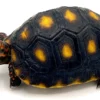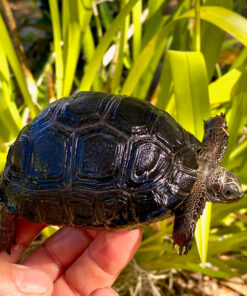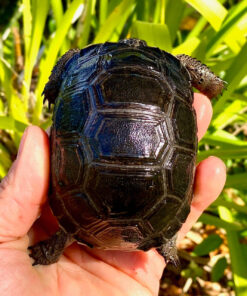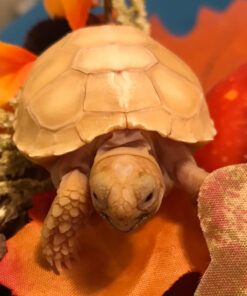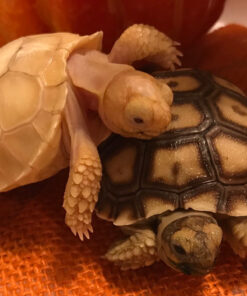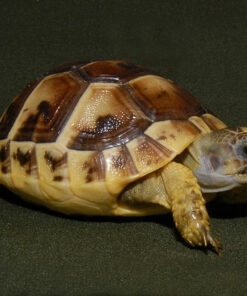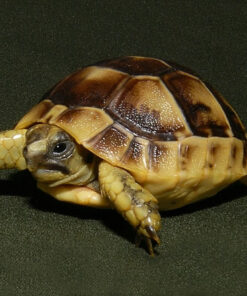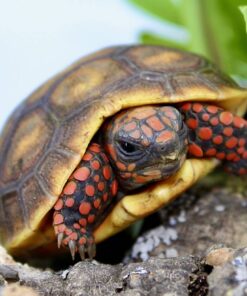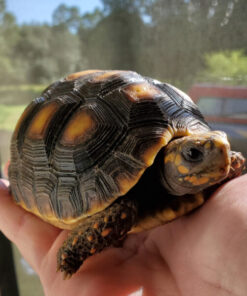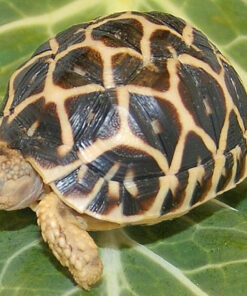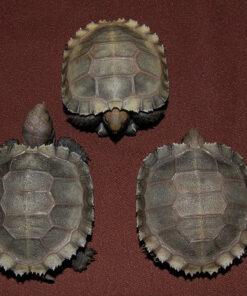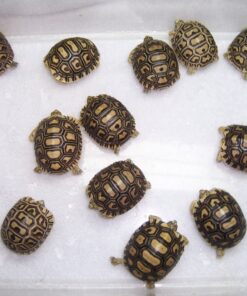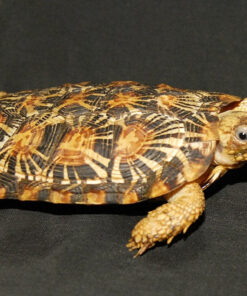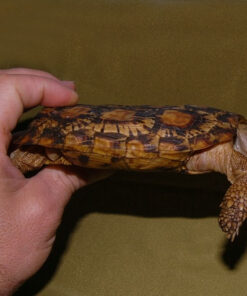$399.99 Original price was: $399.99.$295.00Current price is: $295.00.
Captive Baby Sri Lankan Star Tortoise in shell length, with stunning individual star patterns on each section of their shells. Perfect for any collection or first-time owners.
Category: TORTOISE for sale
Sri Lankan Star Tortoise for sale: A Unique and Exotic Pet for Reptile Enthusiasts
The **Sri Lankan star tortoise** (Geochelone elegans) is a stunning and unique species of tortoise, highly sought after by reptile collectors and enthusiasts around the world. Known for their intricate star-like patterns on their shells, these tortoises are native to Sri Lanka and are recognized as a separate subspecies of the Indian star tortoise. Their beauty and rarity have made them highly desirable, but they also require specialized care, making them best suited for experienced tortoise owners.
In this comprehensive guide, we will cover everything you need to know about the Sri Lankan star tortoise, including their natural habitat, care requirements, and what to expect when purchasing a **Sri Lankan star tortoise for sale**. We’ll also discuss the various factors that affect the **Sri Lankan star tortoise price** and what you should look for when selecting a healthy **baby Sri Lankan star tortoise**.
What Makes the Sri Lankan Star Tortoise Unique?
The most distinctive feature of the Sri Lankan star tortoise is its shell pattern. The shell is dark brown or black with bright yellow or gold radiating lines, which resemble stars, hence the name. This striking appearance not only makes them visually appealing but also serves a functional purpose in the wild, helping to camouflage them in their natural habitat.
Unlike the closely related Indian star tortoise, the Sri Lankan star tortoise is generally larger and has a slightly different shell structure. Adult males typically grow to about 6-8 inches in length, while females can reach up to 12 inches or more. Their star-shaped pattern becomes more pronounced as they age, making older individuals particularly prized among collectors.
Another unique trait of the Sri Lankan star tortoise is its temperament. These tortoises are known to be docile and shy, often retracting into their shells when threatened. They are also solitary animals, preferring to be alone rather than in groups, which is something to keep in mind when considering their housing needs.
Natural Habitat and Behavior
In the wild, Sri Lankan star tortoises inhabit dry forests and grasslands, where they feed primarily on grasses, leaves, and other vegetation. Sri Lanka’s warm, tropical climate provides the ideal environment for these tortoises, with temperatures ranging between 75-85°F during the day and slightly cooler at night. They are accustomed to a seasonal climate, with distinct wet and dry periods that influence their behavior.
During the wet season, Sri Lankan star tortoises are more active, foraging for food and seeking out mates. In the dry season, they tend to be less active, spending much of their time burrowed in the ground to avoid the heat and conserve energy. This seasonal behavior is important to consider when caring for them in captivity, as it helps replicate their natural environment and keeps them healthy.
Housing a Sri Lankan Star Tortoise
Proper housing is essential to the health and well-being of your Sri Lankan star tortoise. While they are relatively small compared to other tortoise species, they still need a spacious enclosure to move around, explore, and exhibit natural behaviors.
Indoor Enclosure
For those living in colder climates or without access to outdoor space, an indoor enclosure is a suitable option. A tortoise table or large terrarium works well, but the size of the enclosure should be at least 4 feet by 4 feet for a single adult tortoise, with additional space for larger individuals. Baby Sri Lankan star tortoises can be kept in smaller enclosures initially, but they will need more space as they grow.
The enclosure should have a solid substrate that allows for burrowing, such as a mixture of coconut coir, topsoil, and play sand. The substrate should be kept moist but not wet, as Sri Lankan star tortoises prefer a humid environment, especially when they are young. The enclosure should also include plenty of hiding spots, such as rocks, logs, and plants, to help the tortoise feel secure.
Lighting is critical for indoor enclosures. You will need a UVB light to simulate natural sunlight, which is essential for the tortoise’s metabolism and shell health. A basking spot should be provided, with temperatures ranging from 90-95°F, while the rest of the enclosure should be maintained at around 75-85°F during the day. At night, the temperature can drop to 70°F.
Outdoor Enclosures
If you live in a warm climate, keeping your Sri Lankan star tortoise in an outdoor enclosure can provide many benefits. Outdoor enclosures allow for natural sunlight, which is the best source of UVB light. The enclosure should be secure, with walls that are at least 12 inches high to prevent escape, as tortoises are skilled climbers and burrowers.
The outdoor enclosure should include a variety of plants and grasses for grazing, as well as hiding spots to protect the tortoise from the sun and potential predators. Providing a shallow water dish is also important, as tortoises need regular access to clean water for drinking and soaking.
### Diet and Feeding
Sri Lankan star tortoises are herbivores, and their diet should consist primarily of leafy greens, grasses, and vegetables. In captivity, a well-balanced diet is essential to prevent nutritional deficiencies and ensure proper growth.
Some of the best foods to offer include:
– Dandelion greens
– Collard greens
– Mustard greens
– Turnip greens
– Endive
– Escarole
– Timothy hay or grass
Occasionally, you can offer other vegetables like squash, carrots, and bell peppers, but leafy greens should make up the majority of their diet. Fruits should be avoided, as they can disrupt the tortoise’s digestive system.
Calcium is also crucial for shell and bone health. Dusting their food with a calcium supplement several times a week is recommended, especially for younger tortoises. Additionally, providing a cuttlebone in the enclosure can give your tortoise a source of calcium to gnaw on as needed
Health and Common Issues
With proper care, Sri Lankan star tortoises are generally healthy and long-lived, often reaching 50 years or more in captivity. However, there are some common health issues that owners should be aware of.
– **Respiratory infections**: These can occur if the tortoise is kept in an enclosure that is too cold or damp. Symptoms include wheezing, mucus around the nose, and lethargy. Providing a proper heat source and maintaining the correct humidity levels can help prevent respiratory infections.
– **Metabolic bone disease (MBD)**: This condition is caused by a lack of calcium or UVB exposure, leading to soft shells and bone deformities. Ensuring that your tortoise has adequate UVB lighting and a calcium-rich diet is essential for preventing MBD.
– **Shell rot**: A fungal or bacterial infection that affects the tortoise’s shell. It can occur if the enclosure is too wet or dirty. Regular cleaning of the enclosure and monitoring humidity levels can help prevent shell rot.
– **Parasites**: Internal parasites can be a problem, especially for wild-caught tortoises. Regular vet checkups and maintaining a clean enclosure will help keep your tortoise free from parasites.
Breeding and Gender Differences
If you’re considering breeding Sri Lankan star tortoises, it’s important to be able to distinguish between males and females. Males tend to have longer tails and a concave plastron (the bottom part of the shell), while females have shorter tails and a flatter plastron.
Breeding typically occurs during the rainy season in their natural habitat, but in captivity, it can happen year-round if the conditions are right. After mating, females will lay eggs in a burrow, and the eggs need to be incubated at around 82-86°F to ensure proper development. After about 90-120 days, the eggs will hatch, and the **baby Sri Lankan star tortoises** will emerge.
Sri Lankan Star Tortoise Price and Where to Buy
The **Sri Lankan star tortoise price** can vary depending on several factors, including age, size, and availability. On average, you can expect to pay anywhere from $500 to $2,000 or more for a healthy tortoise. Prices are generally higher for captive-bred tortoises, as they tend to be healthier and less prone to diseases than wild-caught individuals.
When looking for a **Sri Lankan star tortoise for sale**, it’s essential to purchase from a reputable breeder or seller who prioritizes the health and well-being of their animals. Captive-bred tortoises are always preferable, as they are less likely to carry diseases and have not been taken from the wild, which can harm local populations.
If you’re in the market for a **baby Sri Lankan star tortoise**, be prepared for a higher price, as baby tortoises are often more expensive due to their rarity and the specialized care they require. However, purchasing a baby tortoise allows you to watch it grow and develop its unique personality over the years.
Final Thoughts
The Sri Lankan star tortoise is a remarkable and captivating species that can make a fantastic pet for experienced reptile owners. Their striking appearance, gentle temperament, and relatively small size make them highly desirable, but they also require dedicated care and attention to thrive in captivity.
Before purchasing a **Sri Lankan star tortoise for sale**, be sure to research their specific care requirements and ensure you are prepared to provide them with a suitable environment. Whether you’re looking for a **baby Sri Lankan star tortoise** or an adult, always choose a reputable seller who values the health and well-being of their animals.
By investing time and effort into providing the right care, you can enjoy a long and fulfilling relationship with your Sri Lankan star tortoise, a truly unique and exotic addition to your reptile collection.
Related products
TORTOISE for sale
$1,599.99
TORTOISE for sale
$249.00
TORTOISE for sale
$174.99
TORTOISE for sale
$349.99
TORTOISE for sale
burmese brown mountain tortoise for sale | #1 best price in USA
$399.99
TORTOISE for sale
Pancake Tortoise for Sale – Exotic Pets with Unique Flat Shells
$799.99


